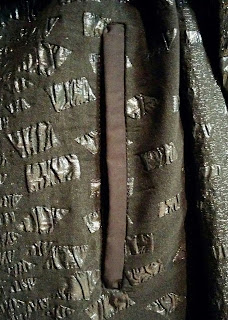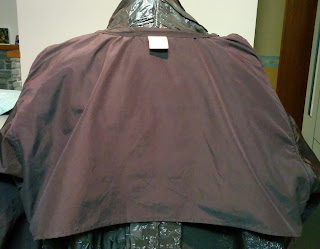The finished garment
This raincoat took five months to finish. I started it in October 2016 originally intending to take it with me to America but I ran out of time to hem it, make the buttonholes and sew on the buttons. There were also some bits that weren't quite as I wanted, which I would have lived with if it had been finished for the trip. Instead it sat unfinished in the pile on my sewing table. In February 2017 it was unearthed and finished. Now we just need some rain - a bit late for the trees which have already shed their leaves but green grass would be nice.
The fabric
Vogue 1836 from 1996 just seemed ideal for this raincoat fabric from Gorgeous Fabrics purchased a few years ago. The only small fly in the ointment is that the pattern requires 5 yards of fabric and I had 3. Now generally Vogue patterns are generous in their fabric allowances but there was no way to eke this garment out of 3 yards. Although I probably came close with the ease I removed!! So off to The Fabric Store to find a complementary fabric to use with it. In the end I only needed this fabric for the sleeves and the extra bits inside like the pockets, back stay and front button flange.
 |
| Gorgeous fabric right side |
 |
| Gorgeous fabric wrong side |
This pattern is advanced, described as an oversized, slightly flared, unlined coat, above mid- knee, has front extending into standing back collar with concealed buttonholes, slightly forward shoulder seams, front shoulder pleats, front button flange, welt pockets, button/tab, back stay, mock bands, stitched hems, longer than regular length sleeves with fold-back cuffs, belt carriers with button/loop.
Oversized is a slight understatement the size small is nearly twice the circumference of my actual body measurements, although some of that is the collar.
One of the questions Pattern Review asks is does this look like the pattern envelope and the answer would have to be sort of. It has the bones of the pattern envelope look just with less ease and a much shorter belt.
The pattern alterations
The fact that I am happy with this garment can be attributed to the teachings of Peggy Sagers of Silhouette Patterns. What I learnt from Peggy after watching her free (and purchased) videos was a real epiphany for my sewing, increasing the frequency of satisfaction with the finished garment hugely.
I no longer make up a garment based on my supposed size on the pattern envelope but by the actual garment measurements that are usually printed on the pattern tissue of Vogue patterns, taking into consideration the amount of ease I prefer. Who knew you could have an ease preference. Well of course you do - when you buy ready-to-wear and the garment drowns you a smaller size is tried on or you leave the garment in the shop. I always loved the look on the pattern envelope but hated my oversized sewn garments without making the connection as to why. I also make garments using my under bust measurement then make an FBA as this fits my shoulders (and frame) much better.
For this pattern the finished garment measurements for the size small were: bust 76"; hip 72"; back length 36¾". I removed 22" of garment ease and added 2¼" to the length. Four inches of ease were removed at each side, front and back straight down from the shoulder seam (total 16") and a further 3" were removed from the collar piece (total 6"). I traced my pattern onto lightweight sew-in interfacing and folded out the unwanted ease as can be seen in the photo. A garment with nearly 30" of ease and with such dropped shoulders I know from experience would drown me and create the look of a child playing dress-up in mum's clothes.
As the pattern had so much ease there was no need for an FBA. The pattern also had a slightly forward shoulder seam so I didn't need to make that adjustment either.
There was a further inadvertent pattern alteration due to a fixation about having the fabric "stripe" run vertically which caused challenges when cutting out. After spending some time puzzling how I could place the body garment pieces on the fabric cross grain so that the "stripes" were vertical the perfect solution suddenly appeared. Actually by this stage I had forgotten about placing the front body pattern piece on the fold at the collar centre back. Forgetting this key instruction led to removing 1¼" from the collar at centre back (the unplanned but now required seam allowance).
I used the longest length for the belt but it is still much shorter than the one in the picture on the pattern envelope.
The sewing
I actually used the pattern instructions to make this garment. Sometimes they caused puzzlement which I worked through and other times I did my own thing as I couldn't solve the puzzle.
There are many pattern markings of different shapes and sizes. I used tailor tacks to mark them on the garment but used the same colour thread and had to keep referring to the front pattern piece as I sewed to identify which tailors tack represented the different markings.
The coat is unlined so I wanted the inside to look as neat as the outside. Luckily the pattern uses faux flat felled seams (sew the seam wrong sides together with a 5/8" seam allowance, trim one side of the seam allowance to ¼" and fold the larger seam allowance around the smaller one and edge stitch).
The single welt pockets caused confusion, much searching on the internet, through books and watching of YouTube videos. Not sure why they caused so much head scratching. Maybe I am too used to the Peggy Sagers method. Issey uses a method closer to that illustrated by Oliver and S. Eventually enlightenment dawned and I was able to follow the instructions to create a neat welt pocket, including enclosed edges created by a french seam on the pocket bag. The other clever thing is the pocket support which attaches to the front flange and the pocket. This keeps the pocket bag in place and stops it sagging.

In October I followed the pattern and had gathers at the neck seam at centre back. This was one of the not quite right parts of the garment which when I came back to the coat in February I decided to fix. The gathers were sufficiently bulky to stick out and give me a strange lump on the back of my neck under the collar. Out came that essential sewing tool the quick unpick. Undoing this neck seam had the added advantage of removing an oopsie pleat in the fabric at the shoulder where the neck and shoulder seam meet. A 3¼" box pleat was created and the neck seam re-sewn. Originally the box pleat was only stitched down 3" from the neck edge but looking at the extra fabric across the back I decided to stitch the box pleat down to the waist. This effectively removed a further 6½" of ease and solved the large tucks of fabric near the armhole caused by excess fabric across the back width, another bit I didn't like about the October version of the garment.
The back stay lays much flatter with the box pleat too.
At the collar centre back there is a button and loop so that the collar can be folded in half. The collar folds over the button down to the neck edge.
The belt has a button loop to secure it to the belt carriers but I didn't like the fact that the button loop is on the public side of the belt. So when I came back to the coat in February I made a second set of smaller belt carriers at the side seams for the button loop to use and be hidden under the belt. In the end the button loop didn't have a button I used a 6mm press stud fastener instead. I also added a belt carrier at centre back secured into the bottom of the box pleat.














This sounds like an epic pattern alteration. That would need a deep understanding of pattern making/alteration. I'm amazed at the amount of ease you took out - surely 30" of ease would look like a sack even on the slimmest woman. I particularly like the shape/fit at the back.
ReplyDelete